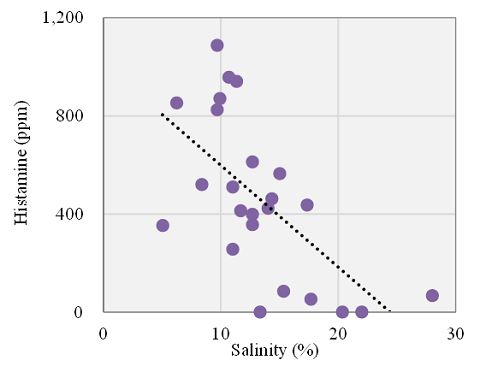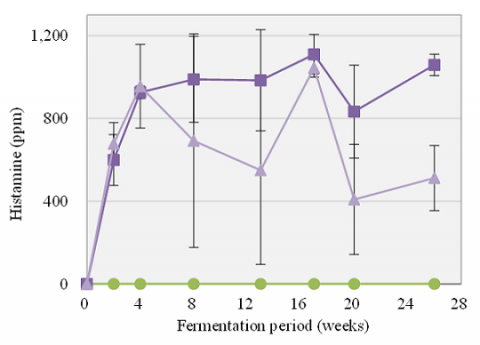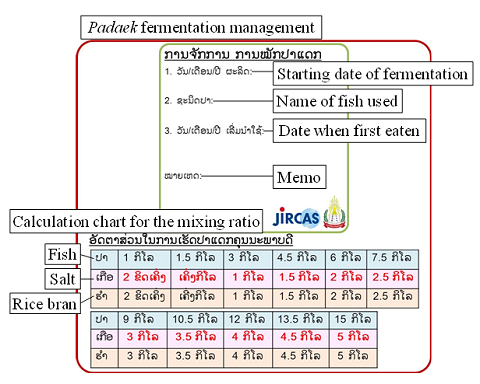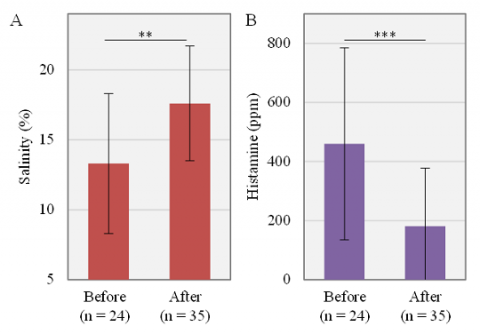Initial salinity adjustment effectively prevents histamine accumulation in padaek, a Laotian salt-fermented freshwater fish paste
Description
Padaek is a shelf-stable salt-fermented freshwater fish paste popularly used for seasoning various Laotian dishes. Pieces of fish remaining in the fermented product can also be cooked for consumption. Although commercial products are currently available, padaek is still made and eaten at home in rural areas to make use of indigenous freshwater fish as an important source of nutrition. In traditional padaek production, the fish are washed with water and then mixed with salt and rice bran at a ratio by weight of 3:1:1 to adjust the salinity to around 20%, which is common in padaek products in Laos. Halophilic lactic acid bacteria, such as Tetragenococcus halophilus and muriaticus, are found in the fermented product. According to the producers, padaek is considered edible after 2 to 3 months of fermentation, with further fermentation for at least 6 months or more to make it more palatable.Histamine is an endogenous substance in the human body, playing an important role in modulating diverse physiological functions. It can also accumulate in amino-acid-containing foodstuffs including fermented fish due to bacteria that possess amino acid decarboxylation activity. The intake of an excess of dietary histamine can cause poisoning symptoms such as stomach upset and hives. Histamine levels of 500 to 1,000 ppm in foodstuffs are considered to be potentially hazardous to human health, although the sensitivity to histamine is largely varied between individuals. Research on the histamine level in padaek and its accumulation mechanism is needed to develop a strategy for preventing excessive histamine accumulation that could adversely affect nutrition security and human health.
Histamine levels in padaek made in rural households negatively correlated with the salinity (Fig. 1). Experimental padaek fermentation with initial salinity of 10% and 6.5% exhibited significant histamine accumulation after 2 weeks of fermentation, while no histamine was detected with initial salinity of 18% for 6 months (Fig. 2), indicating that salinity was a critical factor for controlling the risk of histamine accumulation during padaek fermentation. Households in the rural village were invited to further test the practicability of salinity adjustment to reduce histamine accumulation in their padaek. For that purpose, we prepared a simplified calculation chart (Fig. 3) by referencing a traditional recipe to ensure that the weight ratio of fish, salt, and rice bran was 3:1:1. The participants were instructed on how to use the chart to properly adjust the initial salinity in their padaek fermentation. The average salinity and histamine contents of padaek produced by the participants after the instruction were significantly higher and lower, respectively, than those in the samples collected in the same village before implementing the salinity management practice (Fig. 4), thus demonstrating the usefulness of salinity adjustment for reducing histamine accumulation in their padaek. This producer-friendly approach is recommended for the effective implementation of good manufacturing practice for padaek in Laos.
Figure, table
-
Fig. 1. Negative correlation between salinity and histamine contents (r = 0.633, p < 0.01, n=24) observed in homemade padaek samples collected from rural households
-
Fig. 2. Fermentation period-dependent change of histamine contents in experimental padaek fermentation under salinities of 18% (●), 10% (■), and 6.5% (▲)
-
Fig. 3. Table showing the simplified calculation chart recommended for padaek fermentation
Figure shows English translation of the Lao language used in the table.
-
Fig. 4. Comparisons of average salinity (A) and histamine content (B) of homemade padaek samples collected from the village before implementing the salinity management practice (Before) and the samples from the households after being instructed on how to adjust the initial salinity using the simplified calculation chart (After)
- Affiliation
-
Japan International Research Center for Agricultural Sciences Biological Resources and Post-harvest Division
- Classification
-
Technical
- Research project
- Program name
- Term of research
-
FY2020(FY2016~FY2020)
- Responsible researcher
-
Marui Junichiro ( Biological Resources and Post-harvest Division )
MIERUKA ID: 001765Phouphasouk Souphachay ( National University of Laos )
Boulom Sayvisene ( National University of Laos )
- ほか
- Publication, etc.
-
Marui J et al. (2020) Journal of Food Protection, 84(3):429–436https://doi.org/10.4315/JFP-20-272
- Japanese PDF
-
2020_C04_A4_ja.pdf512.67 KB
2020_C04_A3_ja.pdf512.44 KB
- English PDF
-
2020_C04_A4_en.pdf471.58 KB
2020_C04_A3_en.pdf281.57 KB
- Poster PDF
-
2020_C04_poster.pdf373.21 KB
* Affiliation at the time of implementation of the study.




